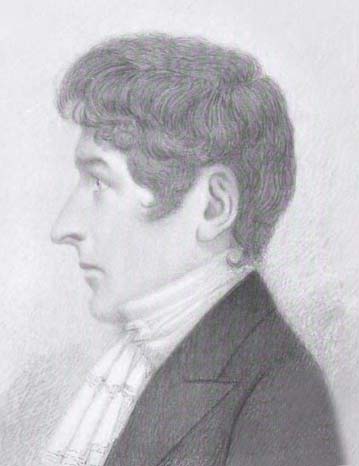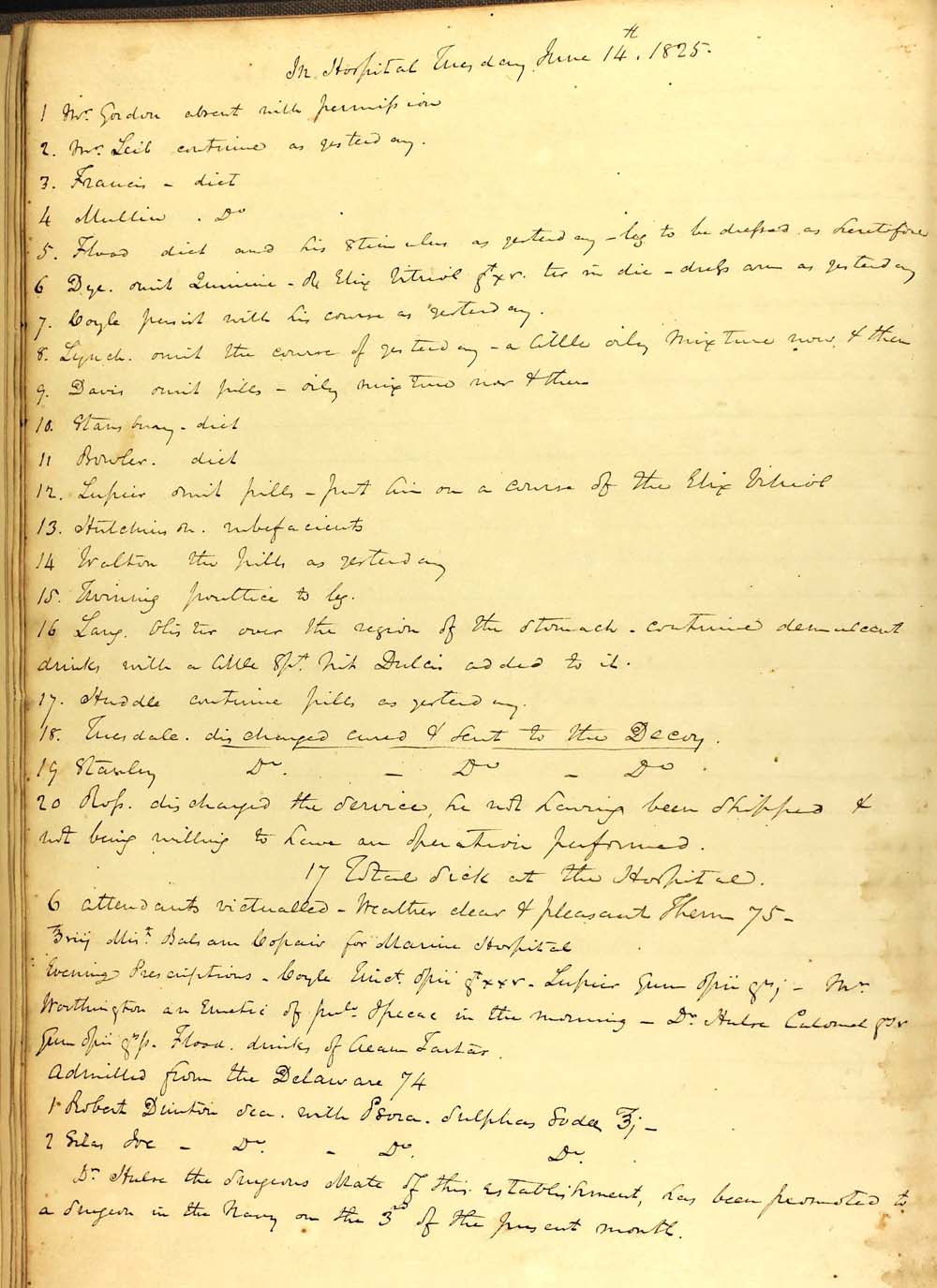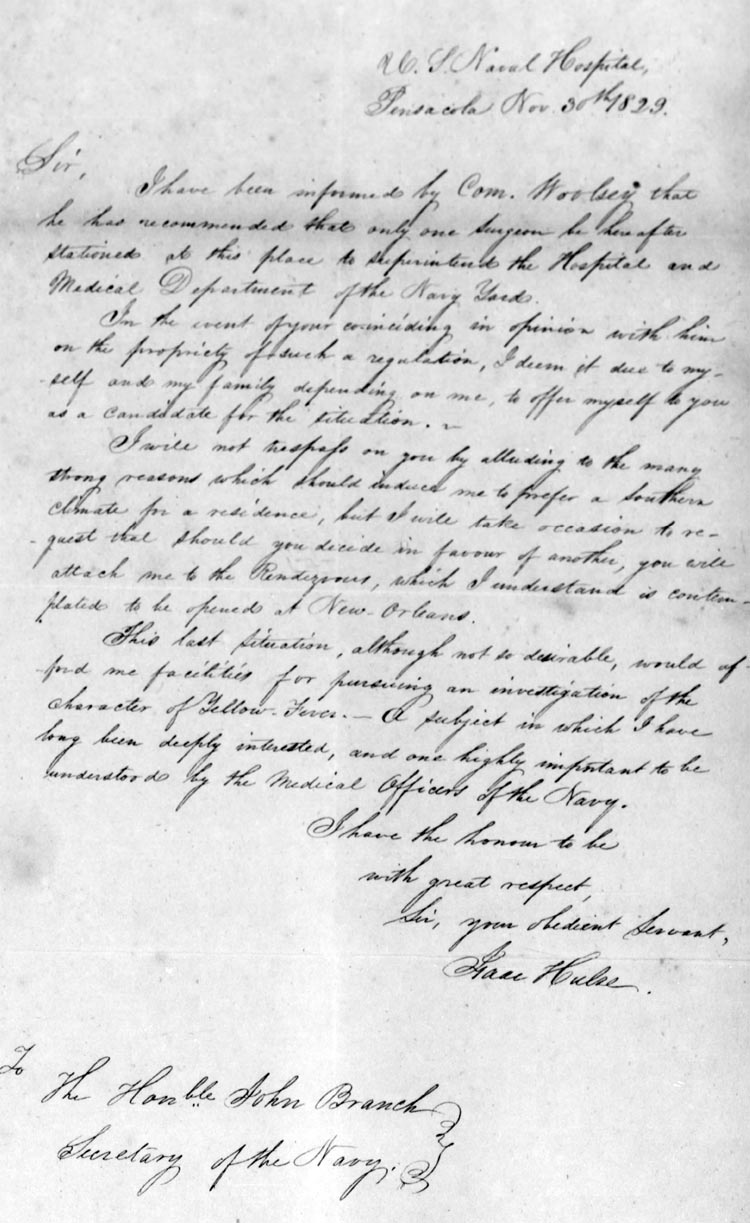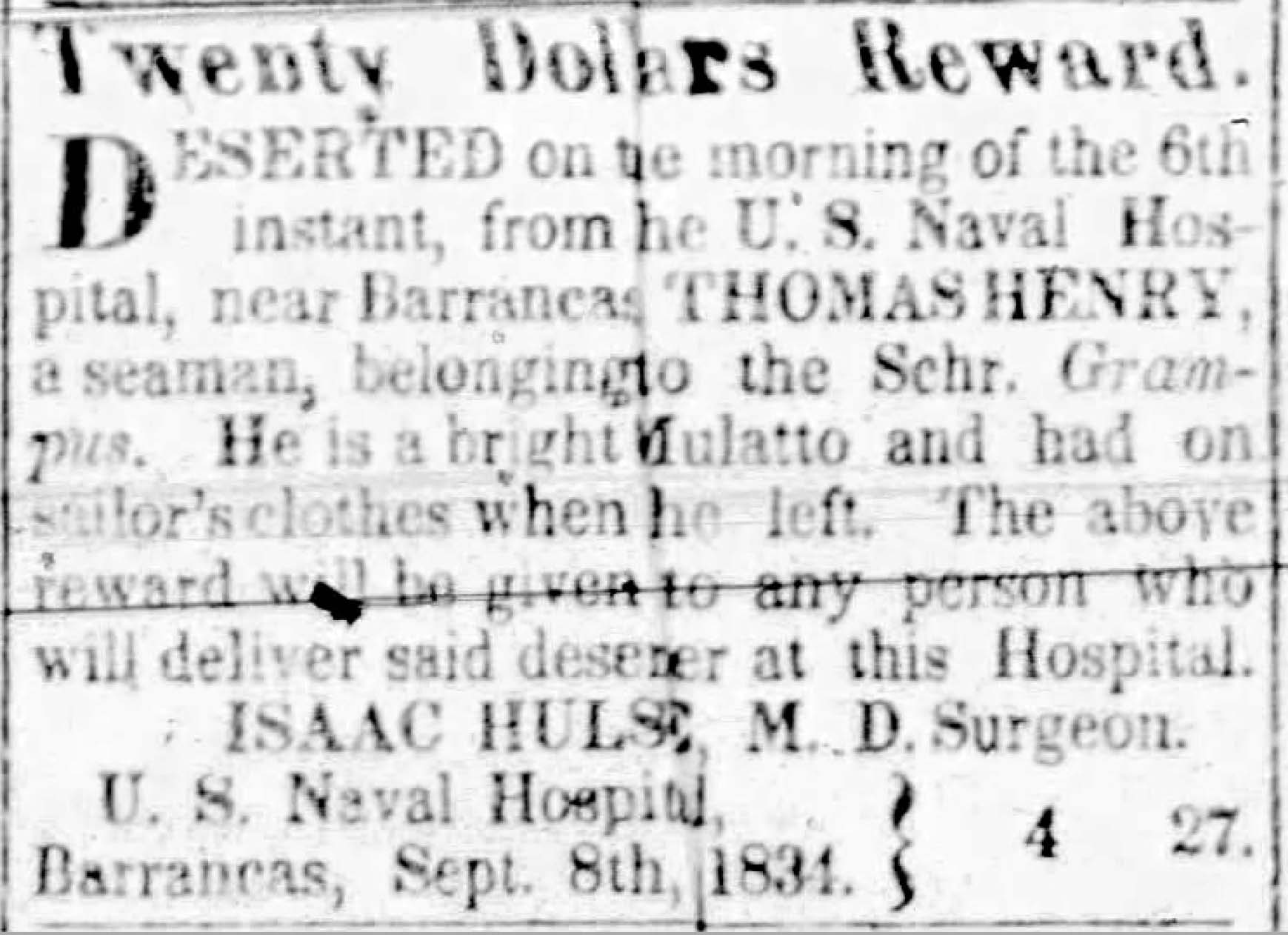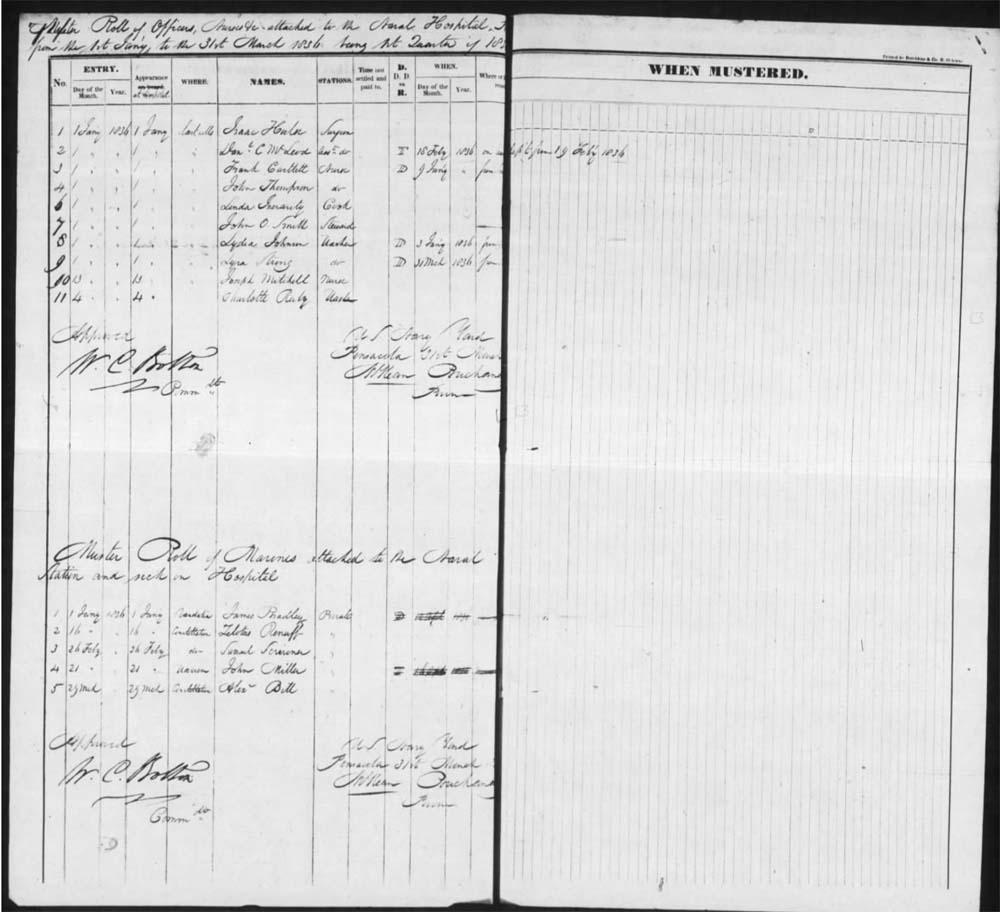Dr. Isaac Hulse, Surgeon USN
Dr. Hulse was born near Coram, Suffolk County, Long Island, New York, on August 31, 1797. He graduated from the University Maryland Medical School where he met and married, Amelia Roberts in 1821. Dr. Hulse joined the United States Navy on May 12, 1823. His first assignment was that of Surgeon’s Mate aboard the U.S.S. Congress based in Norfolk, Virginia. His voyages aboard the USS Congress in the following year, took him to Gibraltar, Cadiz, Rio de Janeiro, the West Indies and the west coast of Africa. Back in the United States in 1821 Dr. Hulse was assigned to the Naval Hospital at Norfolk, Virginia, where he remained for four years. On 14 June 1825 the Gosport Case files reflect “ Dr. Hulse Surgeon’s Mater of this establishment has been promoted to Surgeon in the Navy on the 5th of the present month.” The entry for 11 July 1825 by Dr. Thomas Williamson USN notes “Hulse – there is great danger in this case –tuberculosis with blood…” Dr. Hulse had apparently contracted tuberculosis during his stay in Virginia. He later sought assignment to Pensacola Navy Yard for the milder climate where he believed that the nearby salt air helped his condition. In 1826 Hulse was assigned to Naval Hospital Pensacola Florida. In August 1827 his wife Amelia died while on the return voyage from Pensacola to New York and was buried at sea. In contrast to his colleagues, Dr. Hulse had requested this most arduous and dangerous assignment. At Barrancas he rented two a story dwelling as a hospital and attempted to bring quality medical care to a hard pressed military community. On 10 January 1833 Hulse married Melania Innerarity daughter of John Innerarity a wealthy planter. Hulse spent considerable time urging the construction of new purpose built hospital (he was particularly keen to move the hospital and his patients from the tempting local grog shops) but because of military construction funding delays, the Naval Hospital was not completed until December 1835. His monograph on “Yellow Fever” was published in the Maryland Medical and Surgical Journal, April 1842. In September 1847 Hulse tragically lost his seven year old daughter Mary Victoria to the dread disease. Surgeon Hulse served as commanding officer of the Pensacola hospital three times, spending 19 of his 33-year Navy career in northwest Florida before his death of tuberculosis on 29 August 1856. He is buried at Barrancas, National Cemetery located on Naval Air Station Pensacola. Today Surgeon Hulse's Naval Hospital at Pensacola enjoys world renown and his reports provide valuable demographic and medical information for historians. 1
1 Sharp, John G Pensacola Naval Hospital Records, Report of Naval Surgeon Isaac Hulse 2011 Genealogy Trails
http://genealogytrails.com/fla/escambia/1827navalhosp.html retrieved 7 March 2019
14 June 1825, Dr Hulse the Surgeons Mate of this establishment, promoted on the 3rd
* * * * * * * * * *
Dr. Isaac Hulse to Secretary of the Navy Smith Thompson 18 May 1823:
This 1823 thank you letter from Isaac Hulse to the Secretary of the Navy, Smith Thompson, was to confirm his warrant as a surgeon's mate aboard the USS Congress then at Wilmington, Delaware. Dr. Isaac Hulse had graduated with a medical degree from the University of Maryland in April 1823. His letter is a good example of how appointments to naval medical officer positions were filled in the first half of the nineteenth century.Medical officers generally entered the naval service as either surgeons or surgeon’s mate. The normal pattern was to enter as surgeon’s mate and after some years advance to the rank of surgeon. Before the creation of the Bureau of Medicine in the 1840’s, all doctors and surgeons desiring an appointment in the Navy either wrote directly to the Secretary of the Navy or secured appointment through a powerful patron. Dr. Hulse was born in Coram, a small village on Staten Island, New York, in 1797. His family was upper middle class and both Dr. Hulse’s father and grandfather had been active in political life.
Charles J. Werner, Hulse’s biographer noted that Dr. Hulse had met President James Madison in 1822/23. Hulse, in his letter to Smith Thompson (also a fellow New Yorker), though states that he had in fact received help from the Vice President of the United States, Daniel D. Thompkins. Thompkins served as Vice President to President James Monroe 1817-1825. Thompkins was from Westchester, New York, and was most likely knew the Hulse family. In either case a quiet word from James Madison or Smith Thompson was sufficient and resulted in Hulse’s securing the desired appointment. Political patronage was a fixture in the national political life and continued until the passage of the 1883 Pendleton Act. Prior to the act, patronage was generally viewed as a positive method of filling positions with loyal supporters. Dr. Hulse was promoted to Surgeon USN in 1825 and went on to enjoy a distinguished career.
John G. Sharp 3 September 2019* * * * * * * * * *
New York May 18th 1823
Honorable Sir
I have been advised by His Excellency the Vice President who has recommended me to your favorable notice that you consent to give me the situation of Surgeon Mate on board the Frigate Congress now about to sail. I avail myself Sir of the earliest opportunity to return my warrant acknowledgments for this expression of your goodness and assure you that I think myself happy it is in my power to accept the appointment.Agreeably to the advice of His Excellency the Vice President I am now on my way to Wilmington Del[aware] where I shall wait for your commands.
I am Sir
With much respect
Your Obedient Servant
Isaac HullHonorable Smith Thompson
Secretary of the Navy
WashingtonSources:
Secretary of the Navy “Officers Letters” M148 NARA RG45 1823 Volume 74 -75
18 May 1823Charles J. Werner Dr. Isaac Hulse, Surgeon, U.S. Navy, 1797-1856: His Life and Letters (Charles J. Werner: New York 1922), 5
Christopher McKee, A Gentlemanly and Honorable Profession the Creation of the United States Naval Officer Corps 1794-1815 (U. S. Naval Institute Press: Annapolis MD 1991), 30
1823 Muster of the Frigate USS Congress,
Dr. Isaac Hulse enumerated as no.409 "Acting Surgeons Mate" entered on duty 22 May 1823.
(enlarge in browser)
* * * * * * * * * *
Note: This 30 November 1829 letter from Dr. Isaac Hulse USN to John Branch Secretary of the Navy, reflects Dr. Hulse's passionate commitment to cure yellow fever, a priority for naval medicine. Though he never was able to find a cure for yellow fever, he continued to work tirelessly to treat all those suffering from the disease. Even after his young daughter, Mary Victoria Hulse's tragic death of yellow fever, at age eight, in 1848, Dr. Hulse never gave up his quest for a cure; though ill with tuberculous himself, he promoted science over fear. Dr. Hulse is a model physician.
U. S. Naval Hospital
Pensacola, Nov. 30, 1829Sir:
I have been informed by Com. Woolsey that he has recommended that only one Surgeon be hereafter stationed at this place to superintend the Hospital and Medical Department of the Navy Yard.
In the event of your coinciding in opinion with him in the propriety of such a regulation, I deem it due to myself and my family depending on me to offer myself to you as a candidate for the situation.
I will not trespass on you by alluding to the many strong reasons which should induce me to prefer a Southern climate for a residence, but I will take occasion to request that should you decide in favor of another, you will attach me to the Rendevous which I understand is contemplated to be opened at New Orleans.
This last situation, though not so desireable, would afford me facilities for pursuing an investigation of the character of Yellow Fever - a subject in which I have long been deeply interested, and one highly important to be understood by Medical Officers of the Navy.
I have the honor to be
with great respect
Sir, your obedient Servant
Isaac HulseTo the Honorable John Branch
Secretary of the Navy* * * * * * * * * *
This twenty dollars reward, for Thomas Henry, a seaman, of the USS Grampus was posted by Dr. Isaac Hulse USN. * Seaman Henry, a free black man, deserted on the morning of the 6 September 1834, from the U.S. Navy Hospital Pensacola.** In August 1834 the sloop USS Grampus, after months of patrolling the Caribbean and Gulf of Mexico, arrived in Pensacola harbor. During her time in the Gulf of Mexico, her crew was exposed to a variety of tropical illnesses including yellow fever. Thirty-nine Grampus sailors had contacted the disease, including Thomas Henry, and were placed in the navy yard hospital. In all, before the disease had run its course, seventy-eight sailors came down with fever which resulted in a numerous deaths. The number of sick patients quickly overwhelmed the available space and severely tested the hospital’s limited medical facilities. In the U.S. Navy, desertion was a serious offence and accounted for nearly three quarters of all court martial convictions. At Pensacola the desertion of enlisted men remained a critical problem throughout the antebellum era (see 15 and 16 September 1836 for further accounts of deserters).*** The new Naval Hospital was not completed until December 1835. Because of the high desertion rate, Dr. Hulse had repeatedly expressed concern, that his patients might be tempted by the local grog shops, hence the construction of large brick wall around the new facility.
* Clavin, Matthew J Aiming for Pensacola Fugitive Slaves on the Atlantic and Southern Frontiers (Harvard University Press: Cambridge 2015), pp.81-82.
** Pensacola Gazette (Pensacola, Florida), 4 October 1834, p.4.
*** Sharp, John G.M. Early Pensacola Navy Yard in Letters and Documents to the Secretary of the Navy and Board of Navy Commissioners 1826-1840 Part II, http://www.usgwarchives.net/va/portsmouth/shipyard/pensacola-sharp-2.html
* * * * * * * * * *
Note: The Pensacola hospital was typically staffed by physician, Isaac Hulse, a physician surgeon's mate acting as his assistant, two or three male nurses, a hospital steward, hospital cook, and four or five enslaved "washers" or laundresses. Through his 1833 marriage to Melania Innerarity, daughter of John Innerarity, a wealthy planter, Dr. Hulse came into land holdings in Alabama, Louisiana, and Florida plus numerous enslaved individuals, which gave him "the opportunity to hire slaves for Navy Yard work”.
Source: Dibble, Ernest E., Antebellum Pensacola and the Military Presence (Pensacola News Journal: Pensacola, 1974), p.64.
Pensacola Naval Hospital Muster Roll, Jan 1 to March 31, 1836
(enlarge in browser)
* * * * * * * * * *
Norfolk Navy Yard Table of Contents
Birth of the Gosport Yard & into the 19th Century
Battle of the Hampton Roads Ironclads
